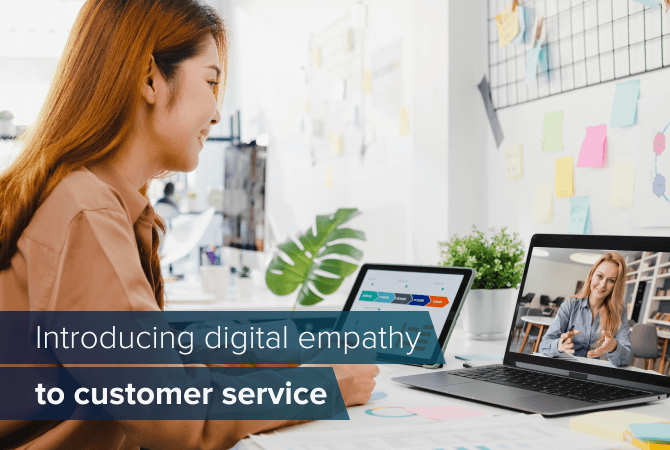
Digital empathy in customer service
Content
Life gets more and more digital – even feelings. Or what do you think digital empathy is?
In many ways, digital communication is more difficult than a face-to-face conversation. If you communicate via chat, you lack mimic, gestures and tonality to convey your message. You lack feelings and context. Even video calls can proof difficult when people look at a camera or their own image rather than the face of the person they are talking to.
The results? Misunderstandings, misinterpretations, frustration and exhaustion. Many feel exhausted from digital communication. If we apply this to digital customer service, it can lead to even more dissatisfaction.
Cue: digital empathy. To communicate more efficiently in a business context and to avoid discrepancies in modern customer service, people need to develop new skills. Digital empathy is an important soft skill, an aspect of emotional intelligence. But how do you benefit from digital empathy and how do you learn to be empathetic?
Signs of digital empathy
To understand how others feel, why they do what they do and why they think they are right: that’s empathy. You put yourself in someone else’s shoes, try to see where they come from and understand their decisions and actions. And you (re)act accordingly.
Digital empathy is about (re)acting accordingly – in the context of digital communication. Here is what’s important:
- Human communication: With digital technology, chat software and the like it is easy to respond to messages shortly and quickly, or to just leave a “Like” instead of typing out a reply. It is therefore important to let the other person know that they are still communicating with a real human being. A mere computer-like “OK” can mean anything when it comes from a person and be interpreted in a dozen different ways.
- Transparency: In digital spaces, everyone should communicate openly, clearly and honestly, because there is so much room for misinterpretations.
- Real-time or live communication: In face-to-face communication, your reaction is immediate. In Microsoft Teams, however, you can – theoretically – respond whenever you like. If the message is not a priority, you will occasionally respond several hours later. The person who sent you the message will not know why you haven’t responded yet, though. That is why you should answer as soon as possible or indicate that you will answer them later (e.g. by changing your status to “busy” or “do not disturb”).
- Social Listening: In customer service, it is of value to keep track of the user’s or customer’s mood. A social listening tool can help with that. If a problem escalates and the mood turns, companies can respond quickly. It helps them learn more about their users and their behaviors.
Digital empathy meets customer service
Digital empathy is particularly important in departments that are in touch with the customer , because it
- increases customer loyalty,
- strengthens the customer relationship,
- creates more customer centricity, and
- makes it more likely for problems to get solved.
If a company wants to benefit from digital empathy, a certain company culture is required: you need to be convinced that empathy will give you an edge.
Introducing digital empathy to your customer service
How do you make your customers feel welcome in a customer service that is digital?
Listen to your customers: It is not only important to understand your customer’s challenges, but being able to read the situation and know their expectations, too. Customer service employees nowadays have to be able to read between the lines and interpret the mood correctly. Listening means letting your customers speak.
Understand them: Understanding is not only important in our interactions with other people. It starts with designing digital touchpoints in a way that gives people orientation. A return, a complaint or a change of address has to be as easy as possible.
Communicate on a personalized level: Customers feel more appreciated when they don’t feel like a burden or a mere ticket in a ticket system, but are seen as the individuals they are. Call them by their names in chats, e-mails and on the phone, and use their own words and descriptions when talking about a problem.
Ask for feedback: To improve your customer service, you need to know where to start. Ask for their feedback after customer interactions – via e-mail, SMS or social media.
By the way: If you use chat bots to communicate with your customers, this list applies, too. Chat bots should always be friendly, understanding of the user, give them enough time to reply, ask questions and for feedback at the end.
How customer service software fosters digital empathy
Today’s customer service needs to be well organized. The number of channels that customers can contact a company via is growing, and customer service becoming an important key to success. So is software that meets the requirements of modern customer service, for example the Dynamics 365 module for customer service.
Dynamics 365 Customer Service offers three great advantages that help companies introduce digital empathy to their customer service.
- Dynamics 365 Customer Service helps customer service employees make time for their customers, because that is what listening to them and being empathetic takes: time. With many tickets in your pipeline, you do not have the time to really get into your customers’ cases. Dynamics 365 Customer Service optimizes the processes in customer service in a way that working on cases becomes particularly efficient. It offers many opportunities for self service, because not every case requires the attention of an employee. Many of them can easily be solved with automation or knowledge articles, FAQs, virtual agents, community portals or self-service portals. Using IoT (e.g. monitoring devices, automated alerts and remote commands) lets solve problems before they become service cases. That leaves employees with more time for cases which need actual human input.
- The app gives you context to understand your customers and to take care of them in personalized ways. If you want to show your customers you understand them, you need to get to the root of their problem. In Dynamics 365 customer service, service employees can access a comprehensive customer profile as well as a contact history between the customer and the company. That helps them see whether they are dealing with a recurring problem and which measures have already been taken.
- Dynamics 365 Customer Service creates the necessary insights that help you improve your customer service. Digital Intelligence reveals trends and potentials for your customer service and gives you the option to ask for feedback.
Conclusion
Digital technology makes communication easier in many areas. There are many advantages for the company as well as the customers. However, digital technology can also lead to people feeling less appreciated or treated impolitely. This can be avoided with empathetic communication. If you foster digital empathy, you avoid misunderstandings and a bad mood among your customers.
You have more specific questions about Dynamics 365 and its customer service capabilities? Let’s talk then!










